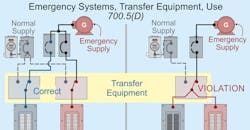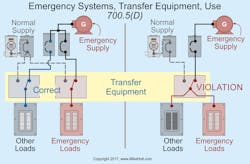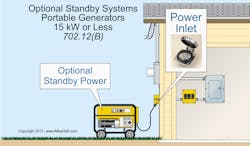In the hierarchy of electrical systems, emergency systems (Art. 700) receive priority. Legally required standby systems (Art. 701) take the number two spot, followed by optional standby systems (Art. 702).
Article 700 applies to systems or equipment required to protect people who are in an emergency and trying to get out.
Article 701 applies to systems or equipment needed to aid the people responding to the emergency. For example, Art. 700 lighting provides an exit path, but Art. 701 might control the elevator used by firefighters to reach the applicable floor.
Legally required standby systems must supply standby power in 60 sec or less after a power loss [Sec. 701.12], instead of the 10 sec or less required for emergency power systems [Sec. 700.12]. The time limit for an optional standby system to kick in is typically determined by a business risk assessment.
Emergency power systems are generally installed to provide illumination for safe exiting and panic control in buildings subject to occupancy by large numbers of persons, such as hotels, theaters, sports arenas, and health care facilities. These systems may also provide power to maintain life, fire detection and alarm systems, elevators, fire pumps, public safety communications systems, industrial processes where interruption would produce serious life safety or health hazards, and similar functions.
Legally required standby systems provide electric power to aid in firefighting, rescue operations, control of health hazards, and similar operations. These systems typically supply loads such as heating and refrigeration, communications systems, ventilation and smoke removal systems, sewage disposal, lighting systems, and industrial processes that, when stopped, could create hazards or hamper rescue or firefighting operations.
Optional standby systems protect public or private facilities or property where life safety doesn’t depend on the system. These systems aren’t required for rescue operations. You’ll see these systems in facilities where loss of power can cause economic loss or business interruptions. A data center, for example, can lose millions of dollars from a single minute of lost power.
Tests and maintenance
These systems must be tested and maintained.
• Emergency system. The authority having jurisdiction (AHJ) must conduct or witness a system acceptance test [Sec. 700.3(A)]. Thereafter, the system must be periodically tested [Sec. 700.3(B)]. It must be maintained per manufacturer instructions and industry standards. And a written record must be kept of all required tests and maintenance [Sec. 700.3(D)].
• Legally required system. The emergency system requirements also apply here [Sec. 701.3].
• Optional standby system. The NEC doesn’t provide maintenance requirements for standby systems. But failure to properly maintain such a system will probably mean a severe financial loss when the system fails to support the load.
Capacity
Emergency system. Must have adequate capacity to carry all emergency loads expected to operate simultaneously [Sec. 700.4(A)]. If an alternate power supply has adequate capacity, it may supply emergency loads [Art. 700], legally required standby loads [Art. 701], and optional standby system loads [Art. 702].
If the alternate power supply lacks adequate capacity to carry the entire load, it must have automatic selective load pickup and load shedding to ensure adequate power in this order of priority: emergency, legally required, optional standby [Sec. 700.4(B)].
Legally required system. Must have adequate capacity to carry all loads expected to operate simultaneously [Sec. 701.4]. Its alternate power supply can supply legally required standby and optional standby system loads if:
(1) The alternate power supply has capacity to handle all connected loads.
(2) There’s automatic selective load pickup and load shedding to ensure adequate power to the legally required standby circuits.
Optional standby system. Must be suitable for the maximum available short-circuit current at its terminals [Sec. 702.4(A)]. Its power source must have capacity to supply the full load transferred. The calculated load must be per Art. 220 or by another method approved by the AHJ [Sec. 702.4(B)]. When a manual transfer switch is used, the system user selects the loads to be connected to the system, and that determines the system kVA/kW rating.
Transfer equipment
With all three types of systems:
• The short‑circuit current rating of the transfer equipment must be field marked on the exterior of the transfer equipment (new with 2017 NEC).
• Transfer equipment must be automatic and be installed to prevent the inadvertent interconnection of normal and alternate sources of supply [Secs. 700.5, 701.5, 702.5].
Transfer equipment for emergency systems must supply only emergency loads (Fig. 1).
Surge protection
A listed surge protective device (SPD) must be installed for all emergency system panelboards and switchboards [Sec. 700.8] (Fig. 2). The NEC doesn’t require this for the other two types of systems, but it almost always makes financial sense to do it.
Circuit wiring
The requirements are in Part II of the respective Article. For legally required and optional standby systems, the system wiring can occupy the same raceways, cables, boxes, and cabinets with other general wiring [Sec. 701.10, Sec. 702.10].
A further requirement for optional standby systems pertains to generators [Sec. 702.12]. If you have a portable generator rated:
• Greater than 15kW outdoors and it’s equipped with a readily accessible disconnect within sight of the building, you don’t need an additional disconnect for the generator feeder conductors that serve or pass through the building — same for permanently installed.
• 15kW or less and it’s installed using a flanged inlet or other cord-and-plug-type connection, you don’t need an additional disconnect for the building (Fig. 3).
For emergency systems, the requirements are much greater. Three highlights [Sec. 700.10]:
(1) Emergency circuits must be permanently marked as components of an emergency circuit or system so they’ll be readily identified.
(2) All wiring to emergency loads must be kept independent of other wiring (unless permitted in 700.10(B)(1) through (5), including wiring in transfer equipment and luminaires supplied from two sources).
(3) Emergency wiring circuits must be designed and located to minimize the hazards that might cause failure due to adverse conditions (e.g., flooding, fire, icing, etc.).
This is where the requirements for optional standby systems end. But emergency and legally required systems have more.
Power sources
Part III of each Article then lists which power sources are permitted and what the requirements are for each source. One difference is Art. 701 lists “connection ahead of service” [Sec. 701(E)] while Art. 700 does not. There aren’t many other differences.
Selective coordination
Overcurrent protection devices for emergency power systems must be selectively coordinated with all supply-side overcurrent protection devices [Sec. 700.32]. The design must be made by an engineer or similarly qualified person. It must be documented and made available to those authorized to design, install, inspect, maintain, and operate the system [Sec. 700.32]. The same thing applies to legally required standby systems [Sec. 701.27].
At this point, the requirements for legally required standby systems end. However, there are more requirements for emergency standby systems.
Circuits for lighting and power
Emergency circuits must supply only emergency loads [Sec. 700.15].
Emergency lighting must include egress lighting, illuminated exit signs, and all other luminaires specified to provide the required illumination [Sec. 700.16].
Emergency lighting systems must be designed and installed so the failure of any individual lighting element (e.g., a lamp) won’t leave dark any space that requires emergency illumination. Consequently, a minimum of two lighting heads is required. This is why an individual emergency lighting unit (sometimes called a “lunchbox”) always has two lighting heads.
When an emergency system is installed, emergency illumination must illuminate the service or building disconnect if the disconnect is indoors.
Multiwire branch circuits aren’t allowed for emergency systems [Sec. 700.19]. Emergency lighting supplied by branch circuits rated not greater than 20A can use a listed branch circuit emergency lighting transfer switch [Sec. 700.25].
Different functions, different priorities
Among these three systems, many of the requirements are the same. Yet, legally required systems have more requirements than optional systems, and emergency systems have more requirements than legally required systems.
Because emergency standby systems protect life, the NEC gives priority to these systems over the other two. And the legally required systems take priority over the optional ones regardless of other considerations. Understanding this hierarchy will help you prevent mistakes in applying this trio of articles.
None of this is to say optional systems are unimportant or optional from a business standpoint. Data centers make theirs extremely robust. At the same time, data centers meet their NEC obligations for the other two types of systems.
Holt is the owner of Mike Holt Enterprises, Inc. in Leesburg, Fla. He can be reached at www.mikeholt.com.About the Author

Mike Holt
Mike Holt is the owner of Mike Holt Enterprises (www.MikeHolt.com), one of the largest electrical publishers in the United States. He earned a master's degree in the Business Administration Program (MBA) from the University of Miami. He earned his reputation as a National Electrical Code (NEC) expert by working his way up through the electrical trade. Formally a construction editor for two different trade publications, Mike started his career as an apprentice electrician and eventually became a master electrician, an electrical inspector, a contractor, and an educator. Mike has taught more than 1,000 classes on 30 different electrical-related subjects — ranging from alarm installations to exam preparation and voltage drop calculations. He continues to produce seminars, videos, books, and online training for the trade as well as contribute monthly Code content to EC&M magazine.




